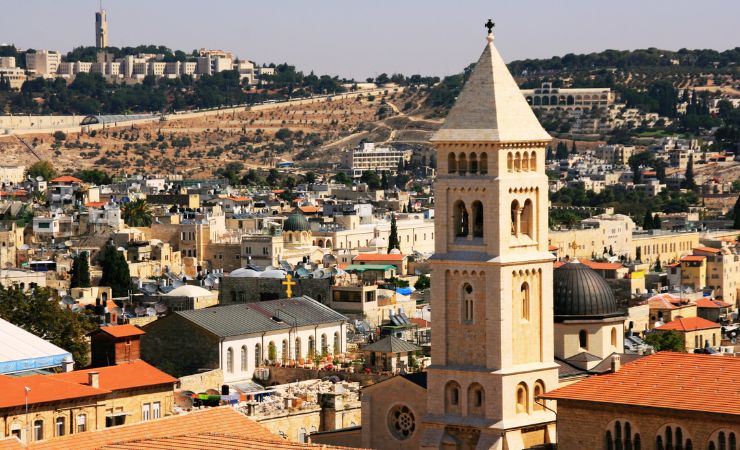In the Footsteps of Unity: The Church of All Nations
Standing majestically amidst the verdant olive trees of Gethsemane, we find an architectural marvel known as The Church of All Nations.
According to the tradition, the church was built over the rock on which Jesus is believed to have prayed in agony. Inside the church, this rock is visible under the altar, and it is the main focus for visitors and pilgrims.
The current Church of All Nations was completed in 1924, but it stands on the foundations of two earlier churches: a 4th-century Byzantine basilica, destroyed by an earthquake in 746, and a Crusader chapel, abandoned in 1345.

Location
The Church of All Nations is located on the Mount of Olives, east of the Jerusalem’s old city. It resides within the sacred confines of the Garden of Gethsemane that holds historical and religious significance.
Biblical Context
The biblical story associated with the Church of All Nations is that of Jesus’ Agony in the Garden of Gethsemane. The event is described by many Gospels in the New Testament (Matthew 26:36-56, Mark 14:32-52, Luke 22:39-53, and John 18:1-12), where Jesus went to the garden with his disciples on the night before his crucifixion.
In the garden, Jesus prayed, expressing his fear and asking God if it would be possible to avoid his impending death. The gospels describe him as being in such agony that he sweat blood. He was betrayed here by Judas Iscariot and arrested by the Romans.
“Then Jesus came with them to a place called Gethsemane, and said to His disciples, ‘Sit here while I go over there and pray.’ He took along Peter and the two sons of Zebedee and began to feel sorrow and distress. Then he said to them, ‘My soul is sorrowful even to death. Remain here and keep watch with me.’ He advanced a little and fell prostrate in prayer, saying, ‘My Father, if it is possible, let this cup pass from me; yet, not as I will, but as you will.’ When he returned to his disciples, he found them asleep. He said to Peter, ‘So you could not keep watch with me for one hour? Watch and pray that you may not undergo the test. The spirit is willing, but the flesh is weak.’ Withdrawing a second time, he prayed again, ‘My Father, if it is not possible that this cup pass without my drinking it, your will be done!’
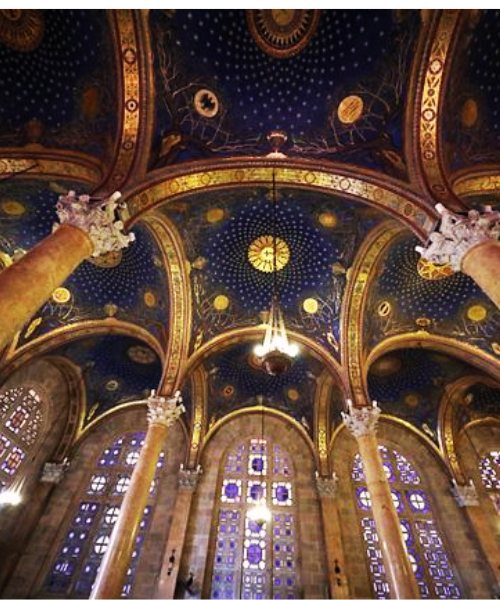
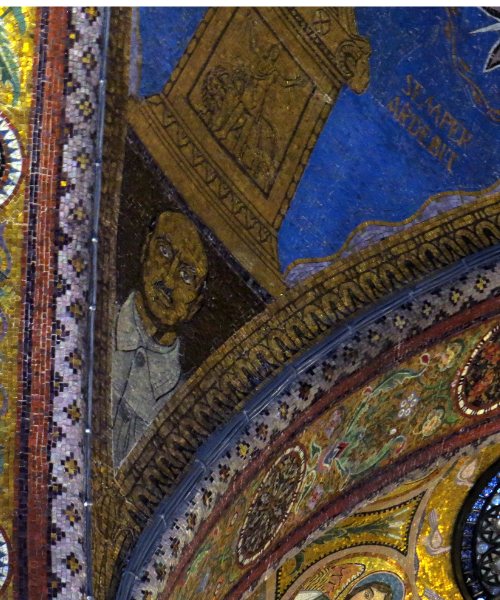
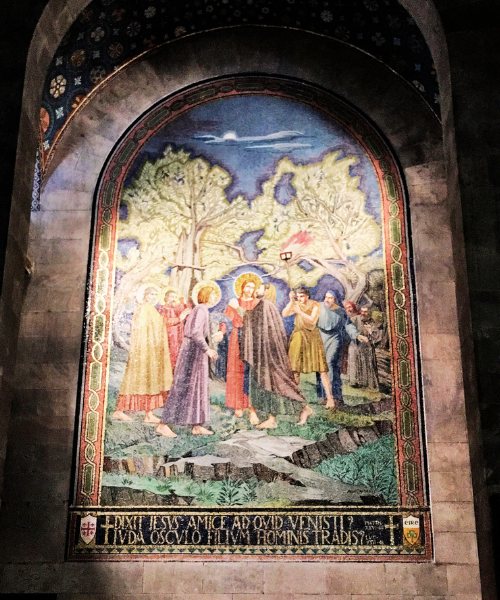
The Architectural Marvel: Antonio Barluzzi
Italian architect Antonio Barluzzi, often referred to as the “Architect of the Holy Land”, was the mastermind behind the Church of All Nations. Commissioned in the early 20th century, Barluzzi skillfully interwove elements of Byzantine and Romanesque architectural styles to craft a space that not only symbolized unity but also depicted the profound biblical events associated with the site. His careful attention to detail and his ability to blend architecture with biblical symbolism sets the Church of All Nations apart as an architectural masterpiece.
The building’s facade is an exquisite display of Barluzzi’s genius, featuring a series of intricate arches, held aloft by slender columns, leading to an impressive entrance. The twelve domes of the church, each donated by a different nation (Argentina, Brazil, Chile, Mexico, Italy, France, Spain, the United Kingdom, Belgium, Canada, Germany, and the United States), culminate in a beautifully decorated central cupola, representing the universality of the Church. This symbolism is echoed throughout the building, particularly on the church floor where the national emblems of the contributing nations are woven into the colorful mosaic.
Additionally, the church is also known as the Basilica of the Agony, a reference to the Agony in the Garden, the biblical event it commemorates. This dual nomenclature emphasizes the historical significance of the site while underscoring its place in the international Christian community.
On entering the basilica, you will be is greeted by the breathtaking vista of the nave, adorned with illustrious frescoes that portray scenes from the passion of Christ. Dominating the apse, an emotionally stirring mosaic depicts Christ in agony, a visual representation of the anguish Jesus experienced at Gethsemane.
The church ceiling, a masterclass in architectural design, comprises a series of small domes. Each dome is intricately decorated with frescoes of angels and the symbols of the nations who contributed to the church’s construction, once again emphasizing the universal nature of the Christian faith.
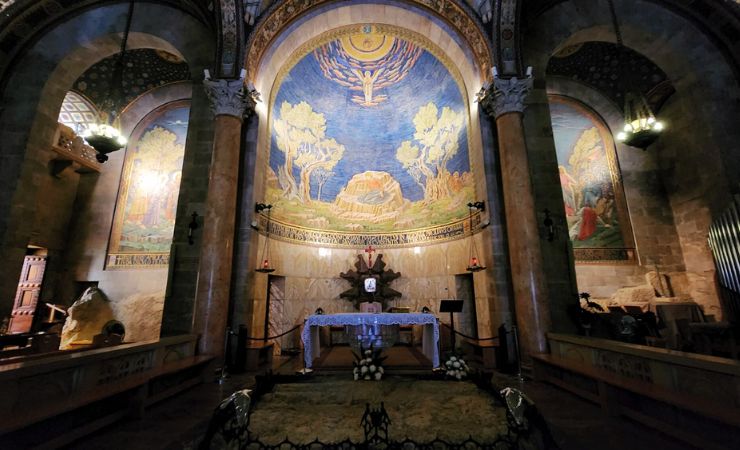
Archeological Findings at the Church of All Nations
Ancient Olive Trees: In the garden surrounding the church, stand ancient olive trees that may date back to the time of Jesus, offering a unique bridge to the biblical past.
Byzantine Mosaics: Beneath the existing structure, remnants of a 4th-century Byzantine basilica and pieces of striking mosaics were discovered, a testament to the site’s religious importance throughout the centuries. Barluzzi integrates these mosaics into the modern floor of the Church.
- Second Temple-era Ritual Bath: In December 2020, during construction work on a modern tunnel beneath the Church of All Nations, the remains of the foundations of a Second Temple-era ritual bath (mikveh) and a 1,500-year-old Byzantine church were revealed.
Crusader Church Foundations: Foundations from a Crusader-era church were discovered during archaeological excavations, providing further evidence of the site’s continued religious use.
Roman Road: The discovery of a Roman road close to the site paints a vivid picture of the area during the time of Christ.
Additional Information
Early Christian Period (up to 70 CE):
- According to Christian tradition (1st Century CE): Jesus went with his disciples to the Garden of Gethsemane, located on the western part of the Mount of Olives, after leaving the temple. This was on the night before his crucifixion. In the garden, Jesus prayed in agony, was betrayed by Judas Iscariot, and was arrested by the Romans. Following the early generations of Christ’s followers: The site was frequented.
- 4th Century: A Byzantine basilica was erected on the traditional site. The Church of the Holy Sepulcher was also constructed in this century.
- 5th Century: Remnants of the mosaic floor from the 5th-century Byzantine basilica were preserved and are visible under the floor of the current church. The crypt of the Greek Orthodox Church of St. John the Baptist dates from this century and is considered the oldest surviving church building in Jerusalem. The Nea Church was built by Emperor Justinian in 543.
- 746: The 4th-century Byzantine basilica was destroyed by an earthquake.
- 12th Century: A small Crusader chapel was built on the site of the former basilica. The Church of St. Anne is an example of surviving 12th-century Romanesque architecture.
- Probably 1347: The large Crusader church that stood at the location was destroyed and abandoned.
- 1919-1924: Italian architect Antonio Barluzzi was commissioned to design the current church. The current Church of All Nations, also known as the Basilica of the Agony, was constructed.
- 1920: During work on the foundations for the new church, discoveries were made that led to the excavation of the earlier Byzantine-era church.
- December 2020: Archaeological reveals occurred of a Second Temple-era ritual bath and a 1,500-year-old Byzantine church beneath the current church.
Nearby Sites
- Dominus Flevit Church: A short walk to the north unveils the Dominus Flevit Church, marking the spot where Jesus wept over Jerusalem’s future destruction.
- Tomb of the Virgin Mary: A mere 200 meters from the Church of All Nations lies the crypt considered to be the final resting place of Mary, mother of Jesus. Next to the entrance to the Tomb is the Grotto of Gethsemane.
- Kidron Valley Tombs: The monumental Kidron Valley tombs offer fascinating insights into Jewish burial practices during the Second Temple period. That include the Tomb of Absalom, the Tomb of Zacharia, and the Tomb of Benei Hezir.
- Mount of Olives Viewpoint: Uphill from the Church of All Nations is a viewpoint that offers a panoramic vista of Jerusalem’s old city – the perfect place to start or end a day of exploration.



